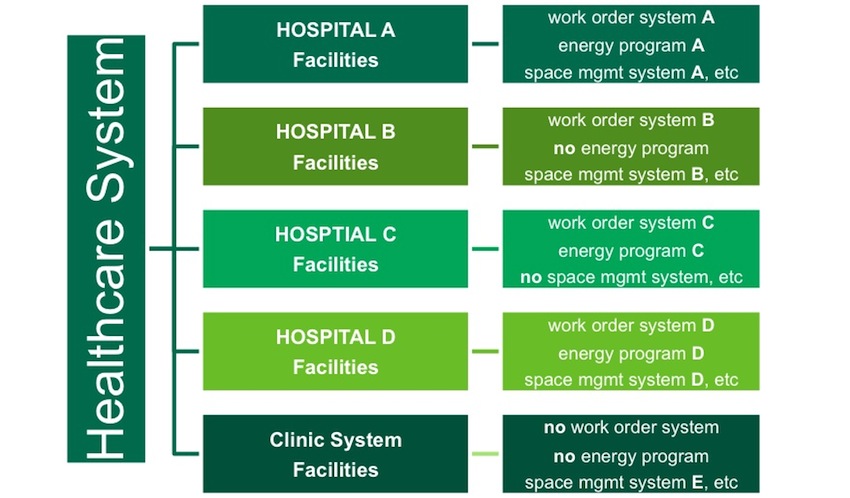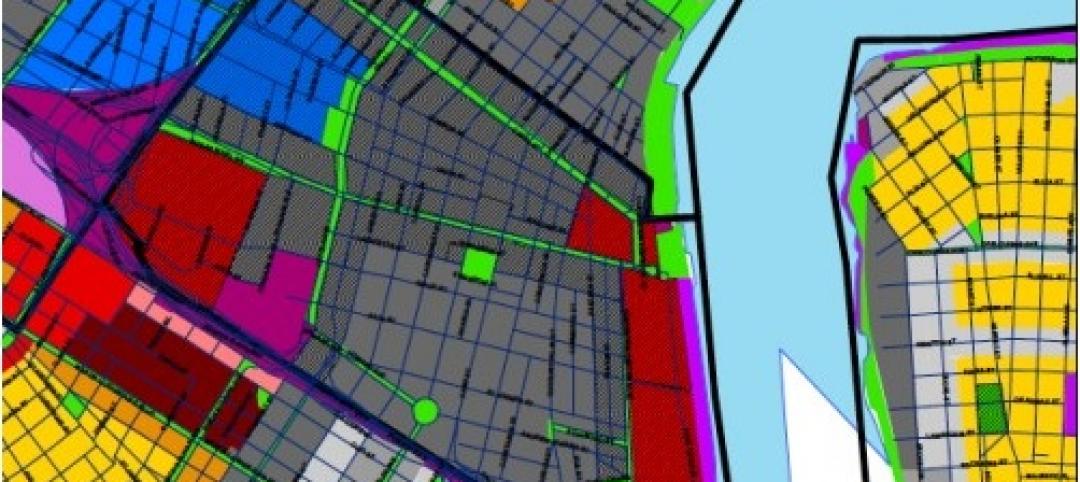As healthcare organizations seek solutions to the challenges presented by today’s evolving marketplace, it’s clear that the cost and performance of their facilities will have a significant impact.
Whether it’s the need to drive cost reduction, respond to regulatory requirements or support changes in patient care delivery models, the effectiveness of an organization’s facilities management program plays a critical role in their ability to provide high-quality, cost-effective patient care.
As healthcare leaders realize the importance of an effective real estate platform, many are finding that transformative changes are needed in order to realize outcomes that cannot be achieved under traditional facility management models.
Confronted by the limitations of their current real estate platforms, many organizations are seeking comprehensive solutions to optimize the performance of their real estate assets.
The tradition facilities management model
Historically, facility management services have been provided on a campus by campus basis or separated into acute care and outpatient programs. In many cases, these programs have been limited to plant operations, which are segregated as an individual support service and function in a silo environment.
Due primarily to organic growth or mergers and acquisitions, healthcare systems often find themselves managing their facilities in a bifurcated manner, with individual hospitals operating more or less autonomously.
While many organizations have identified the goal of standardizing real estate operations across their system, it’s common to find that these initiatives have been in the planning stage for some time. As a result, the inability to proactively manage facility costs and performance at the system level continues to be an obstacle to progress.
Although facility management teams may have a “best-in-class” process at an individual hospital, a lack of resources or resistance to change may prevent that process from being consistently implemented across the system.
Compounding the issue, as each individual campus makes incremental process improvements, they move further and further away from a comprehensive real estate solution. Recognizing that future success will require a systemwide approach to facilities management, continuing with the status quo model increases the cost of change in the future and forfeits the savings that can only be achieved through a centralized real estate platform.
The lack of a comprehensive real estate delivery model also inhibits an organization’s ability to effectively develop essential programs at the system level. Services which are critical for long-term success, such as work order management, energy management, benchmarking, and standardization, are often pursued on a campus by campus basis. These initiatives require the dedication of significant time and resources to collect and reconcile data before creating and implementing the new program.
With disparate facilities management systems at each campus, the process must then be repeated across the system. When evaluating the benefits to be gained through individual campus initiatives, consideration must be given to the cost of replicating the process as compared to the cost and time to market to create one process for the entire real estate portfolio.
The lack of a consistent facilities management program also creates challenges related to business planning at the system level. A common example may be seen in the capital planning process, as the prioritization of projects breaks down due to a lack of reliable comparison data and the absence of analytics based on performance and cost projections.
The process then becomes politically driven, rather than following a disciplined approach based on projected need and justified by consistent business case analyses.
A similar result is frequently displayed when organizations attempt to implement segregated processes related to space allocation. The practice of assigning space based on availability is common, but it creates higher occupancy costs and difficulties in forecasting future demand and associated expenses. This reduces the accuracy of the business cases that drive the decision making process.
Without a comprehensive approach to facilities management, the space allocation process becomes reactive and can lead to the unnecessary construction of new space, when the reality may be that a solution is achievable within the organization’s existing real estate.
Approach to reducing costs
The challenges caused by the lack of a systemwide facility management platform are exacerbated by the traditional approach to reducing costs, which is to cut staffing levels. In the absence of a comprehensive facility management program, these staffing cuts are often a reactive response to an immediate need to reduce costs rather than a component of a long term plan.
While reducing head count generates savings in the short term, these cuts eventually impact the facility management team’s ability to effectively manage preventative maintenance programs and sustain operational efficiency.
When staffing levels approach operational minimums, the ability to be proactive is diminished and the department becomes tactical and reactive.
As the ability to focus on preventive maintenance decreases, the organization’s risk increases and employee satisfaction and performance decreases. At some point, doing more with less is counterproductive and a new approach is needed.
In order to achieve significant improvement, the status quo model must be transformed as part of a centralized delivery model to optimize the performance of facilities and create financially sustainable real estate practices. A comprehensive facility management plan will provide alternative paths to achieving cost reductions, as well as processes to ensure the continued support of patient care.
The path to a solution
In order to achieve lasting results, healthcare organizations should embark on a process to consolidate their existing facility management services into a systemwide, best-in-class real estate platform.
With the volume of changes impacting the healthcare market, having best-in-class facility management will be critical to long-term success.
All aspects of facility services should be included as a baseline delivery model, with adjustments made in policies and processes to address different facility types.
This system-based approach to planning and analytics provides a substantial competitive advantage. Given the time involved in developing and fully implementing real estate plans, organizations that pursue integrated facility management models will have an advantage over their competitors who continue operating as they have in the past.
By the time competitors are able to transform their real estate delivery models, the organizations who were first adopters of integrated facility management will be on program version 2.0 or 3.0 and will retain their competitive advantage.
So, what are the steps taken to achieve a best-in-class real estate delivery model?
STEP ONE – THE REAL ESTATE ASSESSMENT
The first step is to evaluate the cost and performance of the current real estate model. This process should not be an exercise in finger pointing or blame.
The intention is to objectively assess the existing platform in order to generate baseline data which can then be benchmarked campus to campus and against the top performers in the industry.
STEP TWO – AN INTEGRATED FACILITY MANAGEMENT PLATFORM
Once the assessment is complete, it will be possible to produce a gap analysis to identify opportunities to reduce costs and improve processes and performance. These opportunities can then be evaluated by weighing the cost to implement new system based programs against the expected savings or operational benefits.
Each opportunity should be validated as part of a consistent decision process, allowing prioritization based on an organization’s overall business plan and appetite for change.
Although there are sound business reasons to justify the creation of a best-in-class facility management platform, choosing to pursue a systemwide approach represents significant change.
As with any fundamental change from what people have grown comfortable with, there will be resistance. However, as objective data is developed and stakeholders accept that the continuation of the status quo model is unsustainable, this resistance will fade.
When considered objectively, it is difficult to justify the continuation of an inefficient and expensive real estate model in the face of revenue reductions, continuing pressure to lower costs and a need to improve performance.
The purpose of healthcare real estate should be to support the delivery of high quality, cost effective patient care. Provided that consensus can be achieved on the purpose of an organization’s facilities, the change process can be implemented successfully.
STEP THREE – FACILITY MANAGEMENT AS PART OF AN INTEGRATED REAL ESTATE SERVICES MODEL
Once the facility management program is on its way to best-in-class status, it should be integrated with all other real estate services to fully optimize performance.
Ideally, this transformational process will follow concurrent and coordinated schedules across all real estate services, with the objective of developing supportive and complimentary processes among all teams.
Conclusion
As the delivery of patient care evolves, the delivery of real estate services must transform to keep pace. The solution is to transition to an integrated systemwide real estate model, drawing on examples of successful platforms and driving improvements based on quantifiable data and objectives.
A systemwide real estate program, including facility management, project management, facility activation services, property management, strategic real estate planning, real estate accounting and market-based transaction management allows organizations to successfully implement proactive initiatives such as ambulatory prototyping, site selection, labor analytics and workplace environment optimization.
As part of an integrated platform, these programs allow organizations to fundamentally change the way real estate is managed, dramatically reducing year over year expenses and enabling the accurate prediction of future space requirements and the reliable forecasting of associated long term financial obligations.
When truly integrated, the real estate platform will provide cost-effective management of assets and contribute significant value to many internal departments, including strategy and business development, clinic systems, finance, compliance, and procurement.
The benefits of an integrated real estate platform cannot be achieved without completing a comprehensive transformation of the traditional model.
In order to achieve that goal, healthcare organizations should pursue the transformation of their real estate platform by taking the first steps towards a best-in-class facility management program.
Successful healthcare organizations of the future will have integrated real estate services, with facilities that operate at peak efficiency and are proactively managed to respond to and support changes in the delivery of patient care.
Related Stories
| May 17, 2011
Redesigning, redefining the grocery shopping experience
The traditional 40,000- to 60,000-sf grocery store is disappearing and much of the change is happening in the city. Urban infill sites and mixed-use projects offer grocers a rare opportunity to repackage themselves into smaller, more efficient, and more convenient retail outlets. And the AEC community will have a hand in developing how these facilities will look and operate.
| May 17, 2011
Architecture billings index fell in April, hurt by tight financing for projects
The architecture billings index, a leading indicator of U.S. construction activity, fell in April, hurt by tight financing for projects. The architecture billings index fell 2.9 points last month to 47.6, a level that indicates declining demand for architecture services, according to the American Institute of Architects.
| May 17, 2011
Sustainability tops the syllabus at net-zero energy school in Texas
Texas-based firm Corgan designed the 152,200-sf Lady Bird Johnson Middle School in Irving, Texas, with the goal of creating the largest net-zero educational facility in the nation, and the first in the state. The facility is expected to use 50% less energy than a standard school.
| May 17, 2011
Gilbane partners with Steel Orca on ultra-green data center
Gilbane, along with Crabtree, Rohrbaugh & Associates, has been selected to partner with Steel Orca to design and build a 300,000-sf data center in Bucks County, Pa., that will be powered entirely through renewable energy sources--gas, solar, fuel cells, wind and geo-thermal. Completion is scheduled for 2013.
| May 17, 2011
Should Washington, D.C., allow taller buildings?
Suggestions are being made that Washington revise its restrictions on building heights. Architect Roger Lewis, who raised the topic in the Washington Post a few weeks ago, argues for a modest relaxation of the height limits, and thinks that concerns about ruining the city’s aesthetics are unfounded.
| May 17, 2011
The New Orleans master plan
At an afternoon panel during last week's AIA National Conference in New Orleans, Goody Clancy Principal David Dixon and Manning Principal W. Raymond Manning shared their experiences creating the New Orleans Master Plan, a document that sets a new course for the city, from land use and transportation planning to environmental protection.
| May 17, 2011
Do these buildings look like buffalo to you?
It’s hard to contemplate winter now that we’re mid-spring, but when the seasons change, ice skaters in Winnipeg will be able to keep warm in plywood shelters designed by Patkau Architects. The designers created temporary shelters inspired by animal behavior—specifically, buffalo bracing against the wind. Check them out.
| May 16, 2011
USGBC and AIA unveil report for greening K-12 schools
The U.S. Green Building Council and the American Institute of Architects unveiled "Local Leaders in Sustainability: A Special Report from Sundance," which outlines a five-point national action plan that mayors and local leaders can use as a framework to develop and implement green schools initiatives.
| May 16, 2011
Dassault Systèmes to distribute Gehry Technologies’ digital project
Dassault Systèmes and Gehry Technologies announced that Gehry Technologies’ Digital Project products will be integrated into the Dassault Systèmes’ portfolio and distributed through Dassault Systèmes. Digital Project is a suite of 3D BIM applications created by Gehry Technologies using Dassault Systèmes’ CATIA as a core modeling engine.












